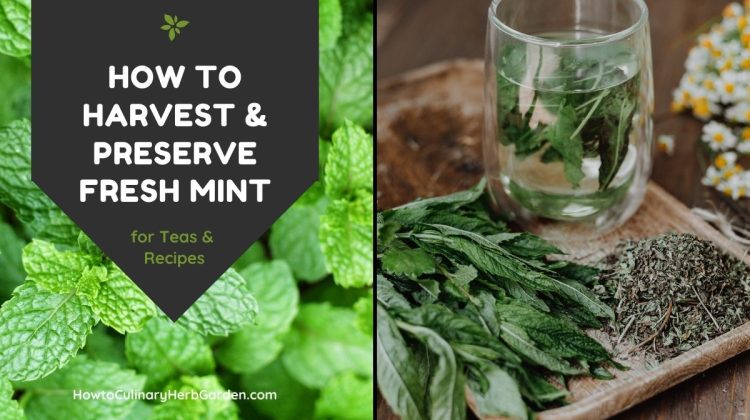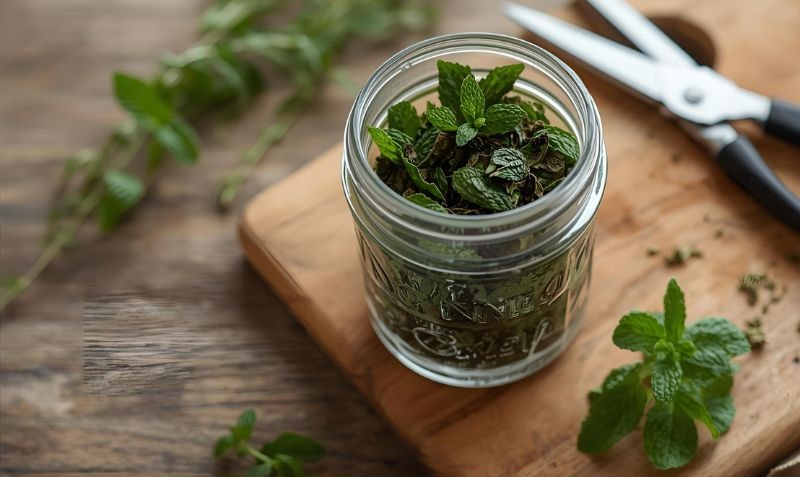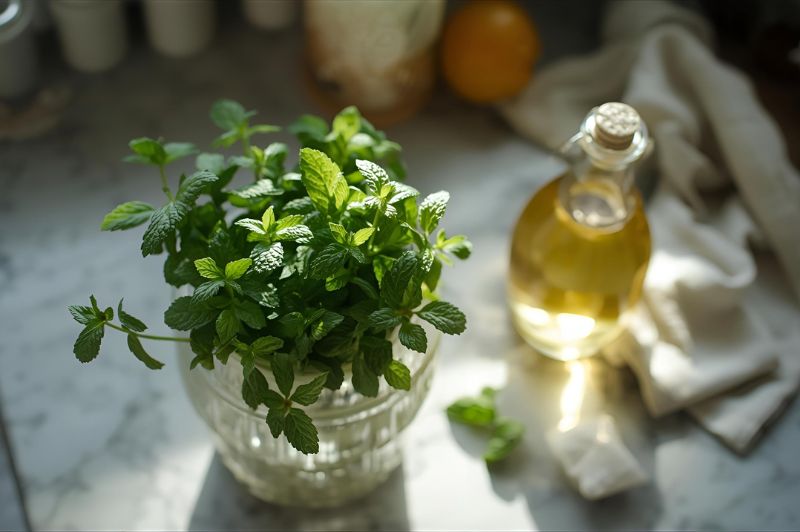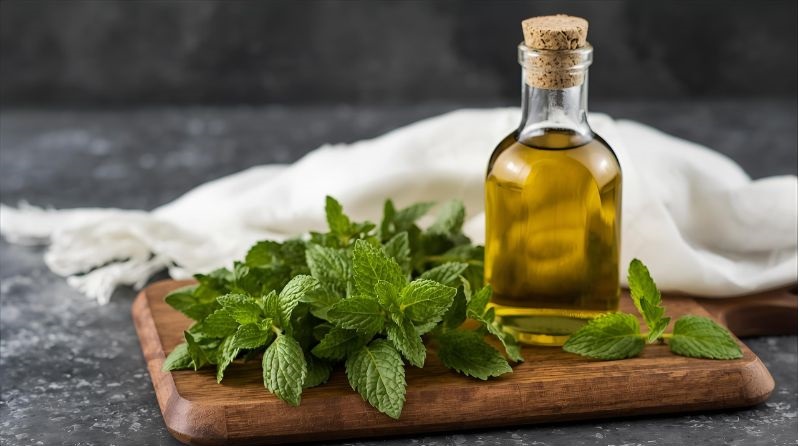
Mint’s fresh smell and taste are delightful in the heat of summer. Read on to learn how to keep your mint plant healthy through the growing season and preserve its leaves to enjoy during the winter.
How to Harvest Fresh Mint from Your Plants
For peak freshness and flavor, harvest mint leaves late in the morning, after the dew has dried and when the plant’s oils are at their strongest.
I’ve harvested mint in two different ways – pinching or cutting whole stems.
Pinching Herb Tips
Most often in my herb garden, I simply pinch off tips, taking 2-4 pairs of leaves. This gets me the freshest and tenderest parts of the mint plant.
Pinching tips consistently also keeps mint from flowering. And mint plants are more robust, and mint leaves more flavorful, before the plant flowers.
You may still want to let some mint plants bloom to attract butterflies and other pollinators.
Harvesting the Stems
Sometimes I’ve cut whole long stems of mint off close to the ground. I’ve done this when harvesting wild mint from fields and pastures, or when cutting back mint that is spreading too far out of the area where I want it.
While the tips have the tenderest leaves, you can get flavorful, usable leaves from further down the stem as well, especially if you harvest the mint before flowering.
Discard any discolored or bug-eaten leaves before you cook with or preserve your mint.

How to Keep It Fresh For a Little While
Mint can keep for up to a week in the refrigerator. If you want to bring a little of the mint indoors, you can prop up its stems in a glass of water as you would flowers in a vase, and then cover them with a plastic bag. You can either set the stems in water or wrap them in plastic.
My mint plants are right outside, and I generally don’t pick more than I want to use immediately, except when I harvest a larger batch for long-term storage.
How to Dry Mint Leaves for Longer Term Use
Mint dries well. You can choose between several different drying methods, depending on what you have available and what parts of the mint plant you’re harvesting.
Long stems can be air-dried whole. Just tie the mint up in bundles and hang it in an airy place out of direct sunlight. When I had very limited indoor drying space, I used to tie bundles of wild mint all over an indoor clothes rack. This allowed me to hang many bundles in a small space while letting the air circulate between them.
The North Dakota Extension office suggests hanging the mint in bags to keep dust off and catch any dried leaves that fall from the stem. Those sound like advantages to me; I can also picture that the bags might reduce air circulation to the plants. You might want to try some each way and see what works best for you.
Tips can also be air-dried in an airy place out of direct sunlight. Spread them out on a screen instead of hanging them up.
If you’re in a hurry, you can dry leaves and tips in a dehydrator or an oven set to 100°F. The Extension suggests using pans lined with parchment paper.
Smaller quantities of mint can be spread on a paper plate or paper towel and dried in the microwave. Time and power settings may depend on your particular microwave model. One master gardener recommends microwaving leaves on high power for 30 seconds initially, checking every 10 seconds and extending the time in 10-second increments if needed.
Dried leaves should feel thoroughly dry and should come off the stems easily. Over-drying in the oven (microwave or conventional) may burn the plants. Rodale’s Garden Problem Solver says that dried mint will hold its flavor for a year if stored in airtight containers.

Other Mint Preservation Methods
There are other preservation options. Choose yours based on what’s easy for you and also on how you want to use your preserved mint.
Freezing
You can freeze mint leaves in at least two ways. One is to rinse them, pat them dry, spread them in a single layer on a cookie sheet, and then freeze them for at least 30 minutes. (If you’re using a chest freezer, as I am, make sure you have a level spot to set your cookie sheet on so the mint doesn’t slide off and get into everything else.) Then put the frozen mint leaves into labeled freezer bags.
You can also snip mint leaves up into ice cube trays, putting about 1 tablespoon of chopped leaves into each cube. Half-fill the trays with water, keeping the leaves underwater as much as you can, and allow to freeze. (Water expands as it freezes, so you’ll end up with your trays more than half full.)
Once the cubes have frozen, add more water to top them off and freeze again. This could be a particularly good way to store mint for use in cold drinks.
Tincture

This method is primarily used for medicinal purposes. Pack fresh, clean mint leaves into a clean, dry glass jar. Pour alcohol over them. The LA Times recommends 80-proof vodka. A friend uses Everclear, which is somewhat stronger, for her echinacea tincture. That’s legal in her state but not in some others. Whatever you use, close the jar with a tight-fitting lid—the Times recommends placing wax paper or plastic wrap over the jar’s mouth. Shake the jar.
Let the mint soak in the alcohol for four to six weeks. Rosemary Gladstar, in her book Medicinal Herbs: A Beginner’s Guide, advises leaving the jar in a warm, sunny spot and shaking it daily.
Then strain out the herbs, pour the tincture into a clean glass jar with a tight lid, and store it in a cool, dark spot. It will keep for several years.
Oil storage

The LA Times also gives a mint oil recipe. Crush mint leaves in a glass jar. Cover them with olive oil or grape seed oil. Put a tight-fitting lid on the jar and shake it. Let it stand for three days. Then strain out the herbs and put the oil back into the jar. Add more mint leaves and cover with more oil. Keep repeating this until you have as much oil as you want.
If you’re thinking of applying this oil to your skin (or to your pet’s coat), dilute a little of it in a large amount of olive oil—the Times gives a ratio of 20 drops of mint oil to 1.5 ounces of olive oil.
Summary
Mint is as easy to harvest and preserve as it is to grow. A little time and effort during the growing season will allow you to enjoy mint’s flavor, fragrance, and health benefits all year long.
